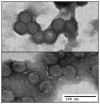MCV and Merkel cell carcinoma: a molecular success story
- PMID: 22710026
- PMCID: PMC3422445
- DOI: 10.1016/j.coviro.2012.05.007
MCV and Merkel cell carcinoma: a molecular success story
Abstract
Merkel cell polyomavirus (MCV), discovered in 2008, is clonally integrated in ~80% Merkel cell carcinoma (MCC). MCV is a common skin flora and initiates cancer in susceptible hosts only after it acquires a precise set of mutations that render it replication incompetent. Both MCV large and small T proteins promote cancer cell survival and proliferation. Large T targets pocket proteins regulating cell cycle transit while small T activates cap-dependent translation critical for cancer cell growth. These findings already have led to new diagnostics and clinical trials to target MCV-induced survivin and to promote antitumor immunity. In four years, the cause, diagnosis and therapy for an intractable cancer has been changed due to the molecular discovery of MCV.
Copyright © 2012 Elsevier B.V. All rights reserved.
Figures




References
-
- Gardner SD, Field AM, Coleman DV, Hulme B. New human papovavirus (b.K) isolated from urine after renal transplantation. Lancet. 1971;1 (7712):1253–1257. - PubMed
-
- Padgett BL, Walker DL, ZuRhein GM, Eckroade RJ, Dessel BH. Cultivation of papova-like virus from human brain with progressive multifocal leucoencephalopathy. Lancet. 1971;1(7712):1257–1260. - PubMed
Publication types
MeSH terms
Substances
Grants and funding
LinkOut - more resources
Full Text Sources
Other Literature Sources
Miscellaneous

